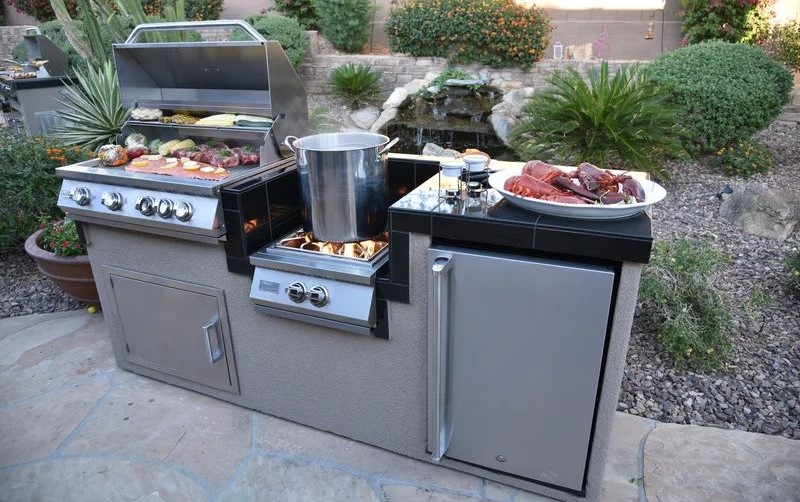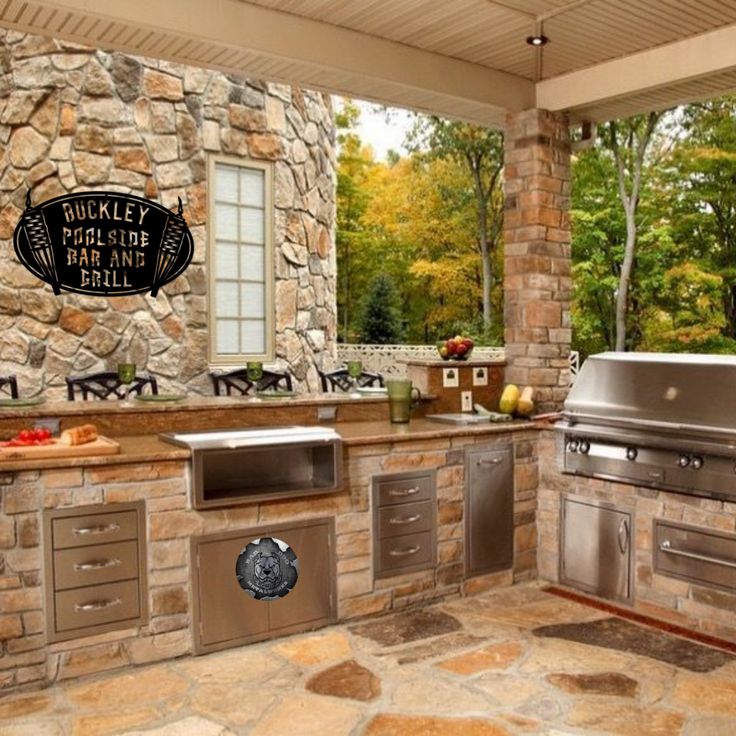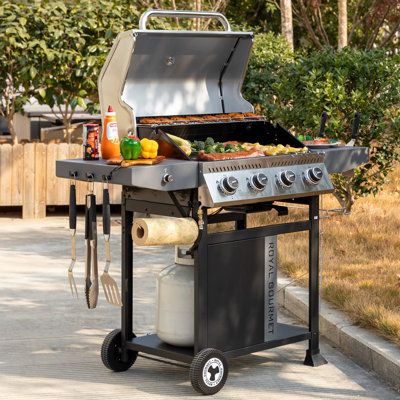A summer cookout is one of the best ways to bring people together. The sound of sizzling meat and the smell of smoke make any backyard or park gathering special. But without the right setup, gas grilling can feel more like stress than fun. Many people do not know what type of grill to choose, how to use it safely, or how to get the most flavor from it.
A gas grill works with burners fueled by propane or natural gas, giving fast ignition, steady heat, and simple control. Choosing the right grill, learning the parts, and using the right tools makes cooking easier, safer, and more enjoyable.
This guide will walk you through the main questions people ask about gas grills. From picking the right size to handling flare ups, you will find practical answers that make your grilling smoother. Keep reading to learn how to get the most from your gas grill.
What is the best gas grill for beginners?
Starting out with gas grilling can be confusing. There are many models on the market, each promising great features. Beginners often want something easy to light, simple to control, and not too costly.
The best gas grill for beginners is one that balances ease of use, safety, and affordability. A two or three burner model with electronic ignition and a built-in thermometer is often the right choice.

Key points for beginners
- Two or three burners are enough for most small families.
- Look for sturdy materials like stainless steel or porcelain-coated steel.
- Electronic ignition saves time and avoids matches or lighters.
- Built-in thermometer helps you learn heat control.
Table: Features beginners should look for
| Feature | Why it matters for beginners |
|---|---|
| 2–3 Burners | Enough space without complexity |
| Electronic Ignition | Quick, safe start every time |
| Temperature Gauge | Learn heat zones and control |
| Sturdy Grates | Prevents sticking, lasts longer |
A small gas grill helps beginners focus on learning the basics of heat and timing without too many distractions. Once you gain skill, you can explore larger models or more advanced features. But a solid entry-level grill builds confidence and keeps frustration low.
How does a gas grill compare to charcoal?
Many people wonder if gas grills can match the flavor of charcoal. Both have loyal fans, and both have strong points. The choice often depends on what you value most.
Gas grills are faster, cleaner, and easier to control, while charcoal grills deliver smoky flavor but require more time, effort, and cleanup.

Main differences
| Factor | Gas Grill | Charcoal Grill |
|---|---|---|
| Start-up Time | 5–10 minutes | 20–30 minutes |
| Flavor | Mild smoky if using wood chips | Strong, natural smoky taste |
| Heat Control | Easy with knobs | Requires practice with vents |
| Cleanup | Wipe grease tray | Dispose of ash and coals |
| Cost of Fuel | Propane/Natural gas moderate | Charcoal can be more expensive |
Gas wins on speed and convenience. Charcoal wins on flavor depth. For someone who grills often during busy weeks, gas is practical. For weekend hobbyists who enjoy the ritual, charcoal may feel more rewarding. Some grillers even own both.
What size gas grill do I need?
Choosing the right size grill is not only about how many people you cook for. It also depends on what foods you cook, how often, and how much space you have.
Most families do well with a three or four burner gas grill, which offers enough cooking area for up to 10 people without wasting fuel.
Size factors
- Cooking area: Look for at least 400–500 square inches for families.
- Number of burners: More burners give better heat zones.
- Space available: Measure your patio, deck, or yard.
- Usage: Frequent entertainers may want 5–6 burners.
Table: Grill size recommendations
| Group Size | Cooking Area Needed | Burners Suggested |
|---|---|---|
| 1–3 people | 250–350 sq. in. | 2 burners |
| 4–6 people | 400–500 sq. in. | 3 burners |
| 7–10 people | 600–750 sq. in. | 4–5 burners |
| 10+ people | 750+ sq. in. | 6 burners |
Buying too small can leave you short on space when entertaining. Buying too large can waste fuel and money. Aim for a grill that fits your daily life, then scale up if you host many guests.
How many burners should a gas grill have?
This is one of the most common questions when shopping. Burners control heat zones and affect cooking style.
Three burners give a good balance for most families, while larger groups may need four to six burners for flexible cooking.
Why burner count matters
- Two burners: Compact, great for small spaces.
- Three burners: Lets you create two heat zones for direct and indirect cooking.
- Four or more burners: Allows multiple heat zones, perfect for big cuts or entertaining.
Table: Cooking styles and burner needs
| Cooking Style | Ideal Burners |
|---|---|
| Simple grilling | 2 |
| Family meals | 3 |
| Indirect roasting | 4 |
| Large parties | 5–6 |
If you plan to smoke or slow-cook meat, extra burners make it easier. But remember that more burners mean a bigger grill, which needs more space and higher fuel use.
What features matter most in a gas grill?
With so many options, it is easy to get lost in extra features. But some matter more than others.
The most important features are durable construction, good heat control, safe ignition, and easy cleaning systems.
Key features to look for
- Material: Stainless steel resists rust.
- Grates: Cast iron or porcelain-coated for heat retention.
- Ignition: Push-button electronic ignition is reliable.
- Heat control: Side vents, knobs, and thermometer.
- Cleanup: Grease tray and removable parts.
Optional features like side burners, rotisserie kits, or LED lights are nice but not essential. Focus on what improves your cooking experience most.
How long do gas grills usually last?
Many buyers want to know if their investment will pay off. The lifespan of a gas grill depends on materials, care, and frequency of use.
A well-maintained gas grill lasts 5–10 years, with premium stainless steel models lasting 10–15 years or more.
Factors affecting lifespan
- Quality of materials (stainless vs powder-coated steel)
- Frequency of grilling
- Storage conditions (covered or exposed)
- Regular cleaning and maintenance
Buying a cover, cleaning grates after each use, and checking burners yearly all extend the life of your grill.
What fuel is best for a gas grill?
Gas grills run on propane or natural gas. Each has pros and cons.
Propane offers portability and flexibility, while natural gas gives steady supply and lower cost if you have a gas line.
| Fuel Type | Pros | Cons |
|---|---|---|
| Propane | Portable, widely available | Tanks need refilling |
| Natural Gas | Continuous supply, cheaper long | Requires home gas connection |
Your choice depends on whether you want flexibility to move the grill or prefer the convenience of never refilling tanks.
How do you maintain a gas grill properly?
Even the best grill fails without care. Maintenance keeps flavor clean and parts safe.
Clean grates, empty grease trays, and check burners often to keep a gas grill safe and working for years.

Maintenance steps
- Preheat before cooking and brush grates.
- Empty grease trays after each session.
- Check burners for clogs once a month.
- Use a cover to protect from rain and dust.
Simple checklist
| Task | Frequency |
|---|---|
| Brush grates | Every cook |
| Empty grease | Every cook |
| Check burners | Monthly |
| Full deep clean | Seasonally |
These habits keep food safe, reduce flare ups, and extend the grill’s lifespan.
How do you prevent flare ups on a gas grill?
Flare ups happen when fat drips onto flames. They can burn food or cause accidents.
To prevent flare ups, trim excess fat, keep grates clean, and control heat with indirect zones.
Tips
- Keep a spray bottle of water nearby.
- Do not overload grill with fatty meats.
- Use drip pans under large roasts.
- Clean grease tray regularly.
With good practice, flare ups can be managed. They are normal but should never get out of control.
What safety tips should you follow when using a gas grill?
Safety is often overlooked but is critical. Gas leaks, fire, and burns are risks if not careful.
Place the grill outdoors in open space, check hoses for leaks, and never leave it unattended while in use.
Core safety rules
- Keep 10 feet away from house or deck railings.
- Test hoses for leaks with soapy water.
- Keep children and pets away.
- Have a fire extinguisher nearby.
Following these rules makes grilling safe for everyone.
Can you use a gas grill for smoking food?
Some people think smoking is only for charcoal. Gas grills can also be adapted.
Yes, you can use a gas grill for smoking by using a smoker box or foil packets with wood chips.
Place chips on one burner and cook food on indirect heat. Keep lid closed to trap smoke. While not as deep as charcoal smoking, it adds noticeable flavor.
What accessories make gas grilling easier?
Accessories make grilling more efficient and fun. Some are must-haves, others are extras.
Useful accessories include a meat thermometer, grill brush, tongs, spatula, drip pans, and a cover.
Table: Gas grill accessory guide
| Accessory | Purpose |
|---|---|
| Thermometer | Ensures food safety |
| Grill Brush | Keeps grates clean |
| Long Tongs | Safe handling of food |
| Spatula | Flips burgers, fish, delicate |
| Drip Pans | Prevents grease flare ups |
| Grill Cover | Protects from weather |
Other extras include pizza stones, rotisserie kits, and LED grill lights for night cooking. Choose based on your style.
Conclusion
Gas grills make outdoor cooking easy, quick, and enjoyable. The right size, burner count, and features help you cook for family and friends without stress. With proper fuel choice, care, and safety, your grill can last many years. Accessories improve convenience and flavor, while small habits like cleaning and using drip pans prevent problems. Whether you are a beginner or an experienced griller, using these essentials ensures every cookout is a success. Gas grilling is about more than food—it is about the moments shared around the fire, with steady heat and great taste every time.
FAQ
What is the average cost of a gas grill?
Most gas grills range from \$200 to \$800, depending on size, features, and brand. Premium stainless steel models can exceed \$1,500 but last much longer.
Can you use propane and natural gas on the same grill?
Only if the grill is designed as a dual-fuel or convertible model. Standard grills require a specific fuel and cannot switch without a conversion kit.
How do you know when propane tank is empty?
You can check by lifting the tank for weight, using a gauge, or pouring warm water down the side. Cold spots show remaining fuel level.
Is it safe to grill under a covered patio?
Gas grills should only be used outdoors in open spaces. Grilling under covered patios can trap heat and gas, creating a fire or carbon monoxide risk.
How often should you replace gas grill burners?
Most burners last 2–5 years depending on use and care. Replace burners if flame is uneven, weak, or shows signs of rust and clogging.
Can you use a gas grill in the winter?
Yes, gas grills work year-round. Preheat longer in cold weather and shield from wind. Keep propane tanks full because cold reduces pressure.
Do gas grills need to be preheated?
Always preheat for 10–15 minutes before cooking. This cleans the grates, ensures even heat, and helps food sear properly without sticking.
What is the difference between BTU and burners on a gas grill?
BTUs measure total heat output while burners control zones. More BTUs do not always mean better performance if the grill design is inefficient.
